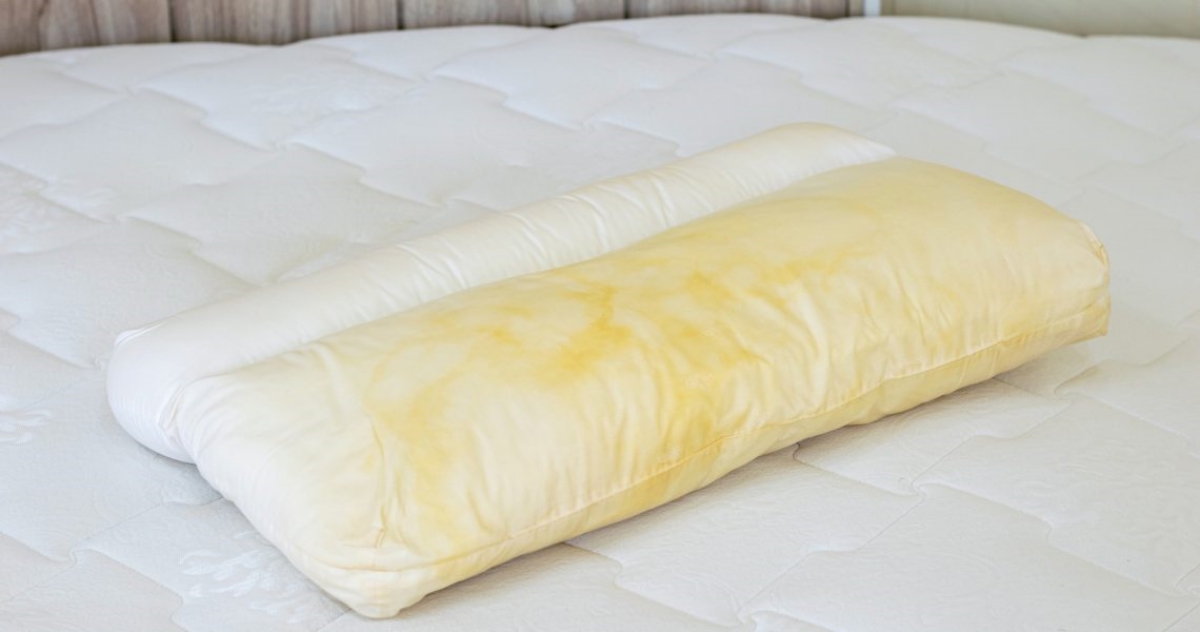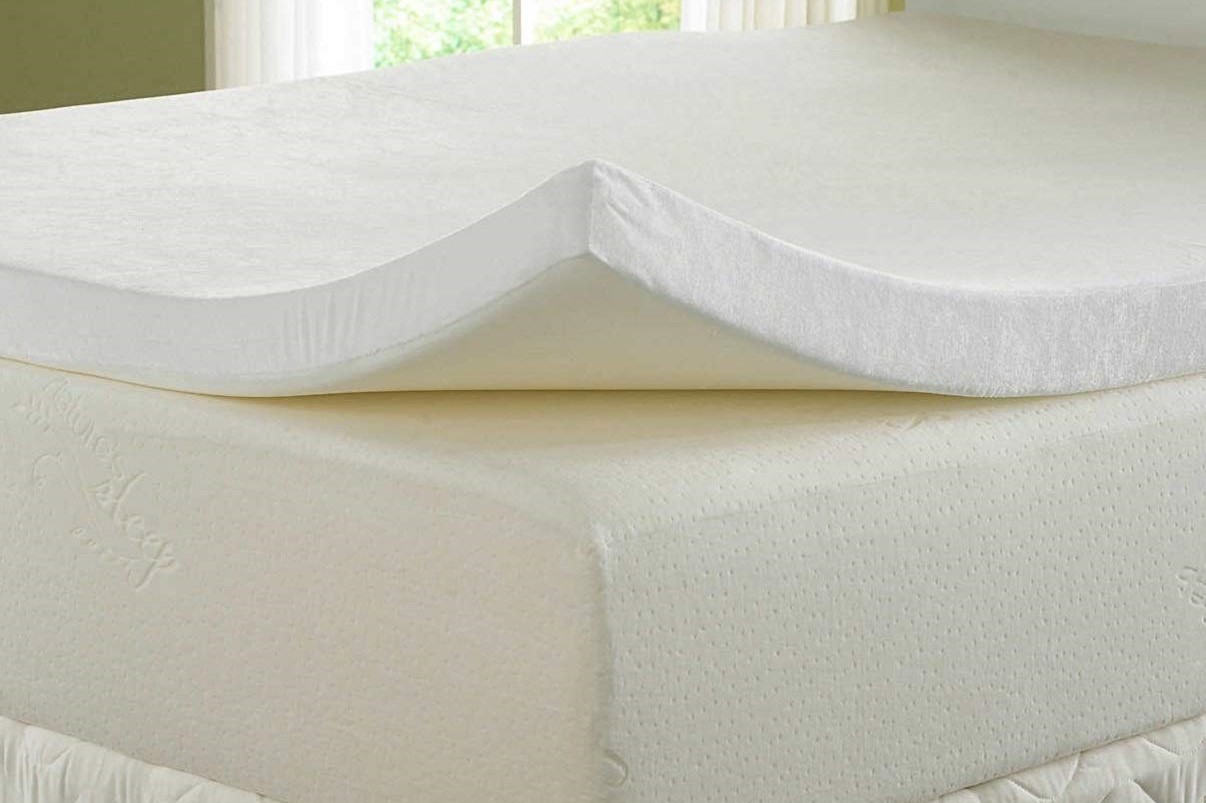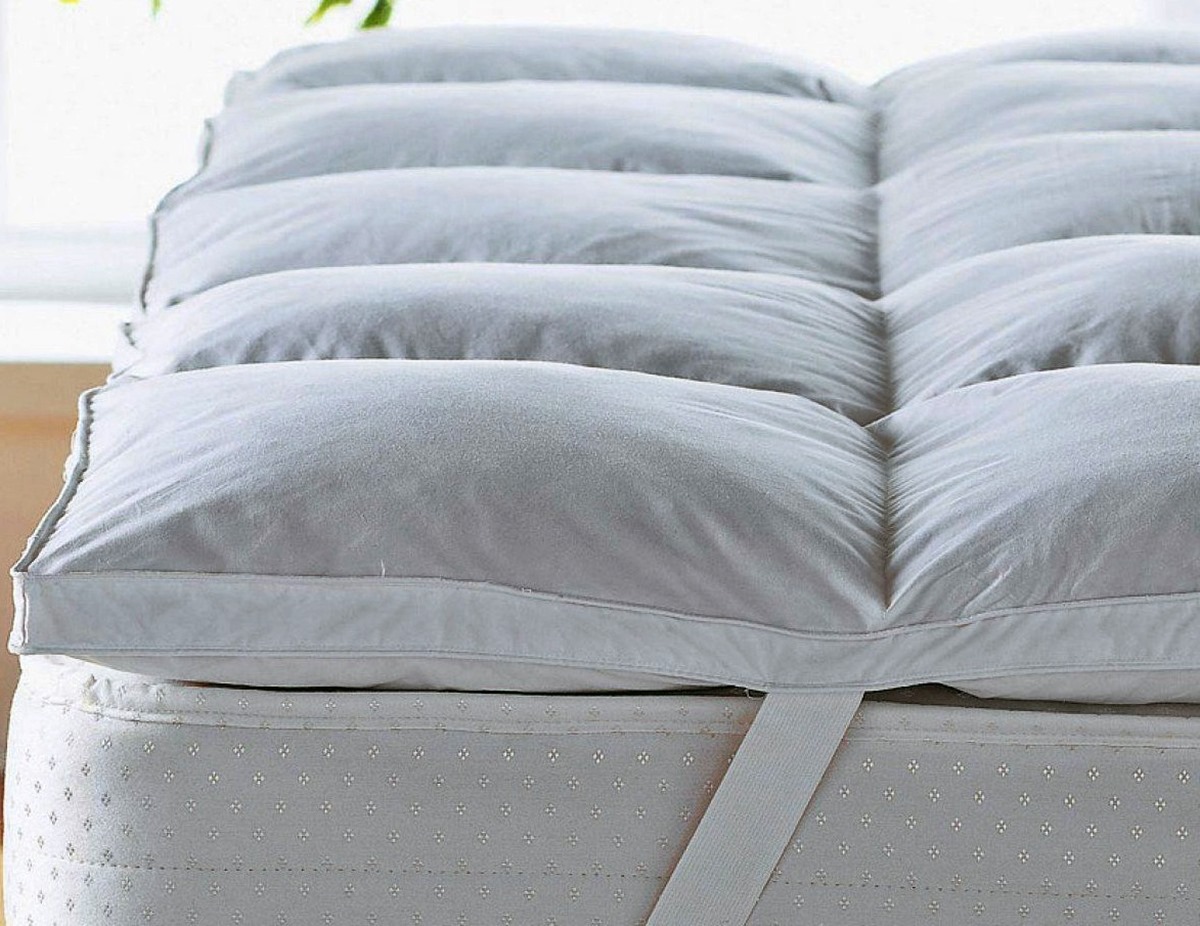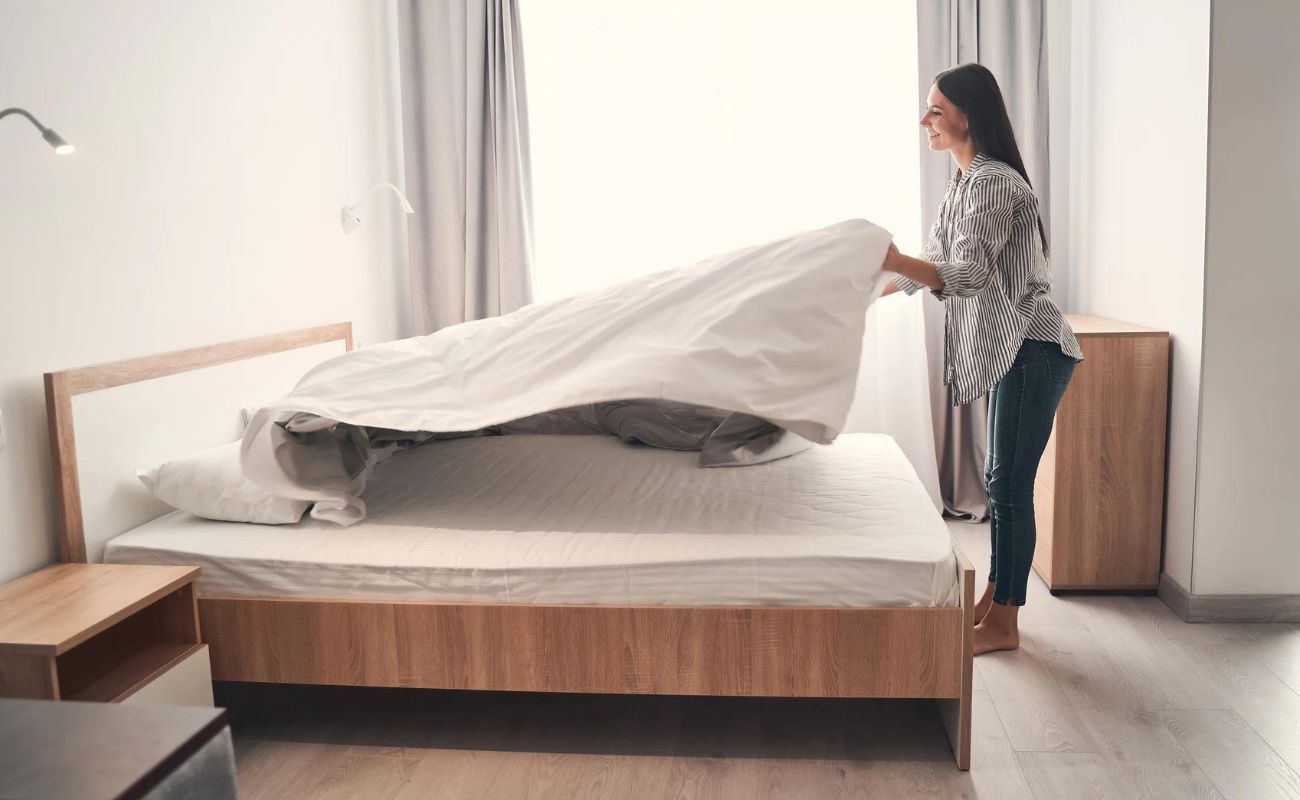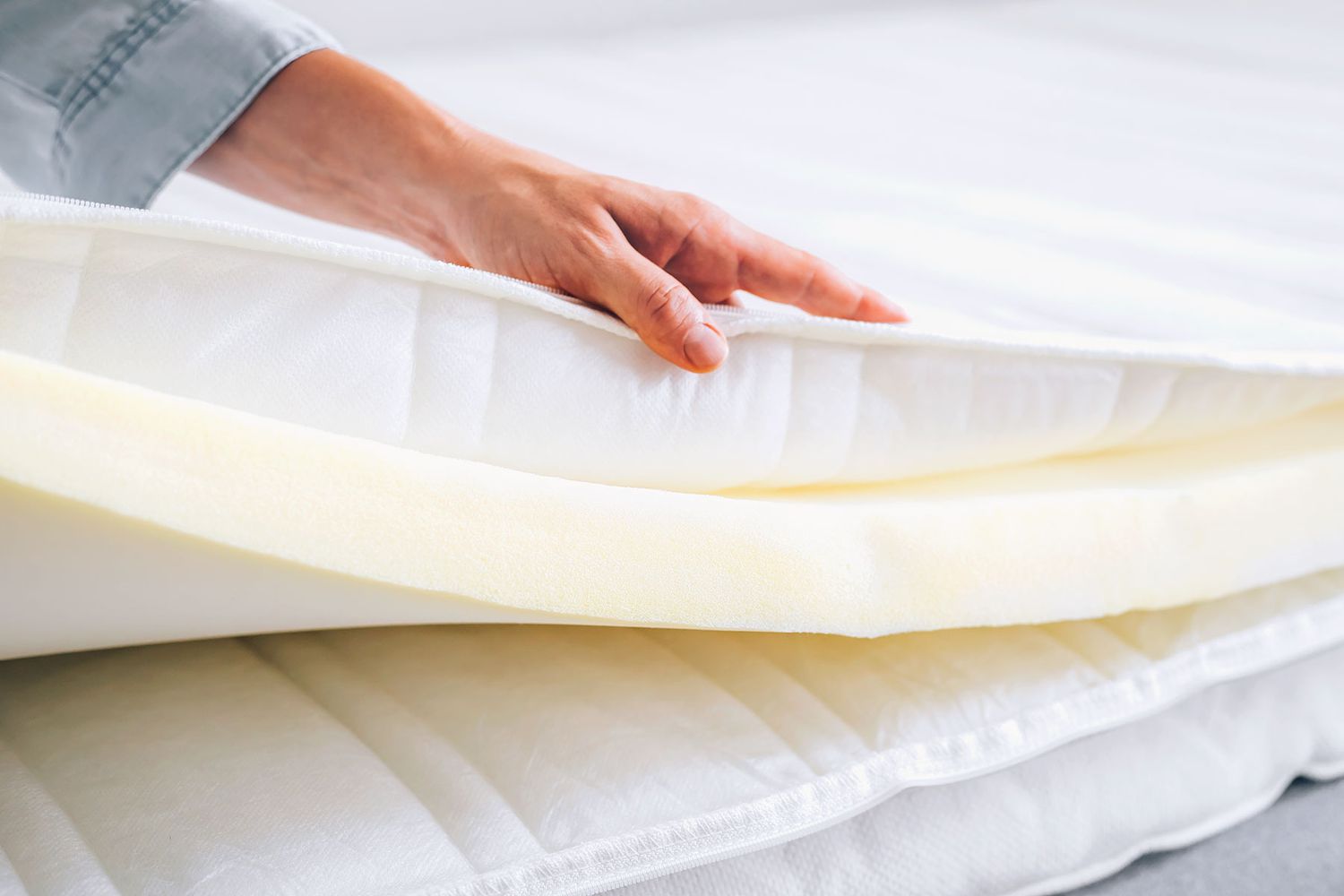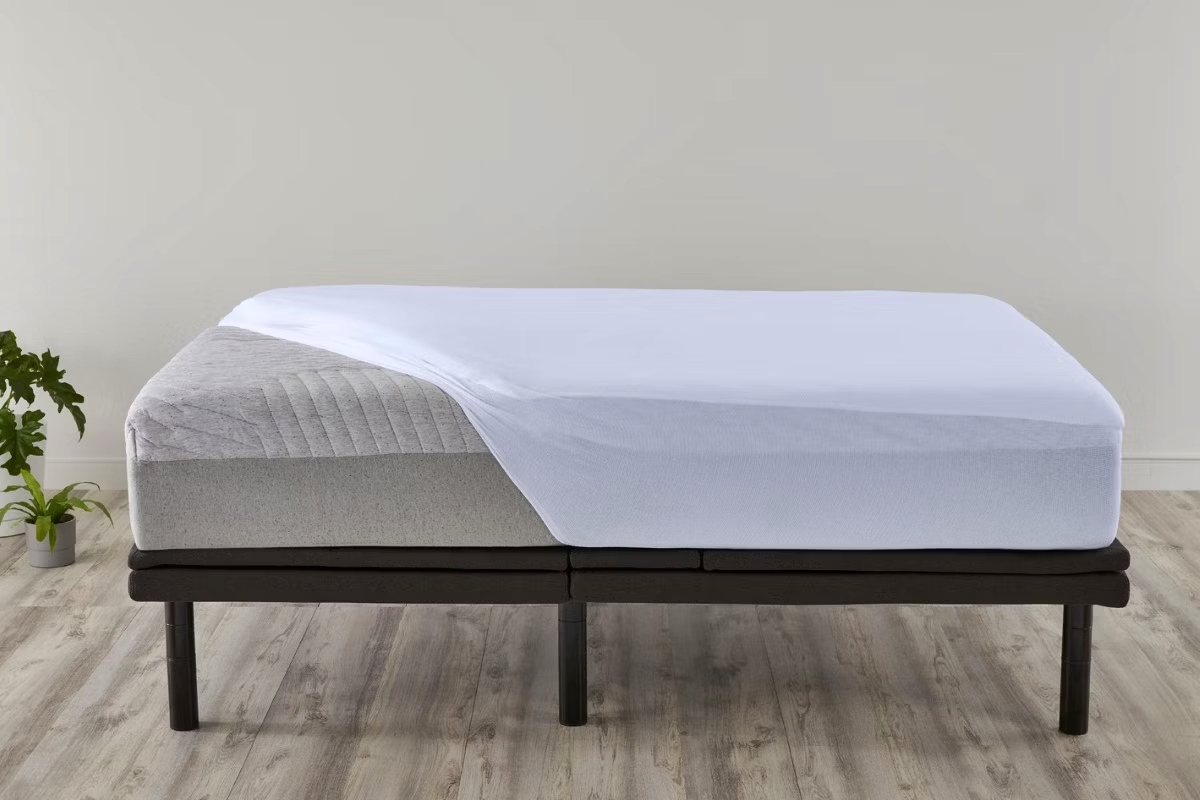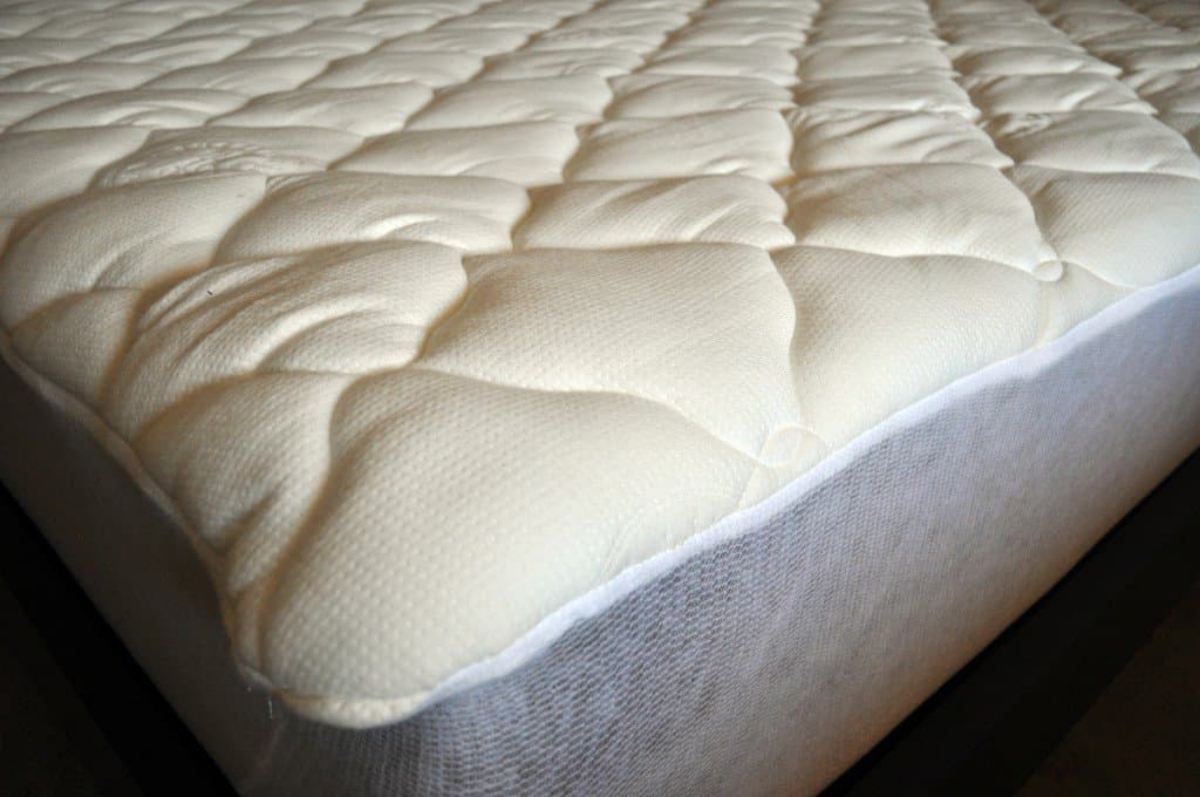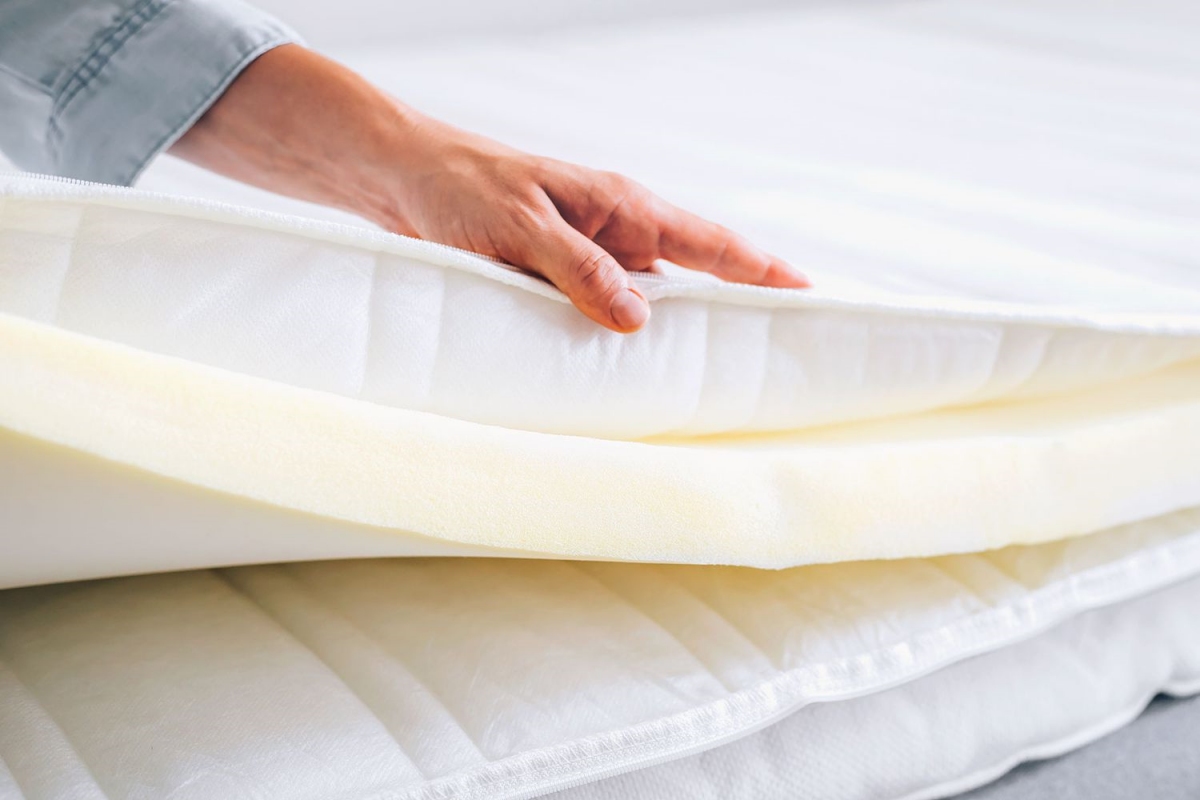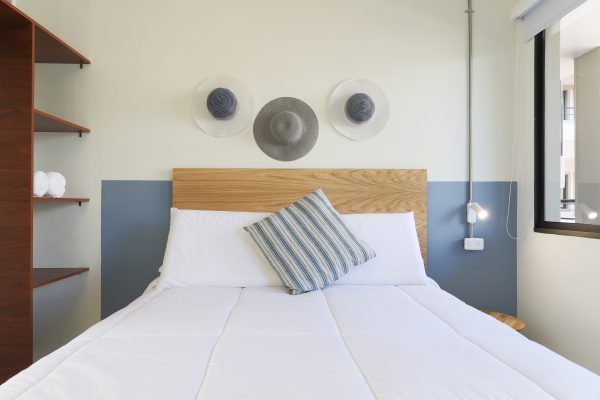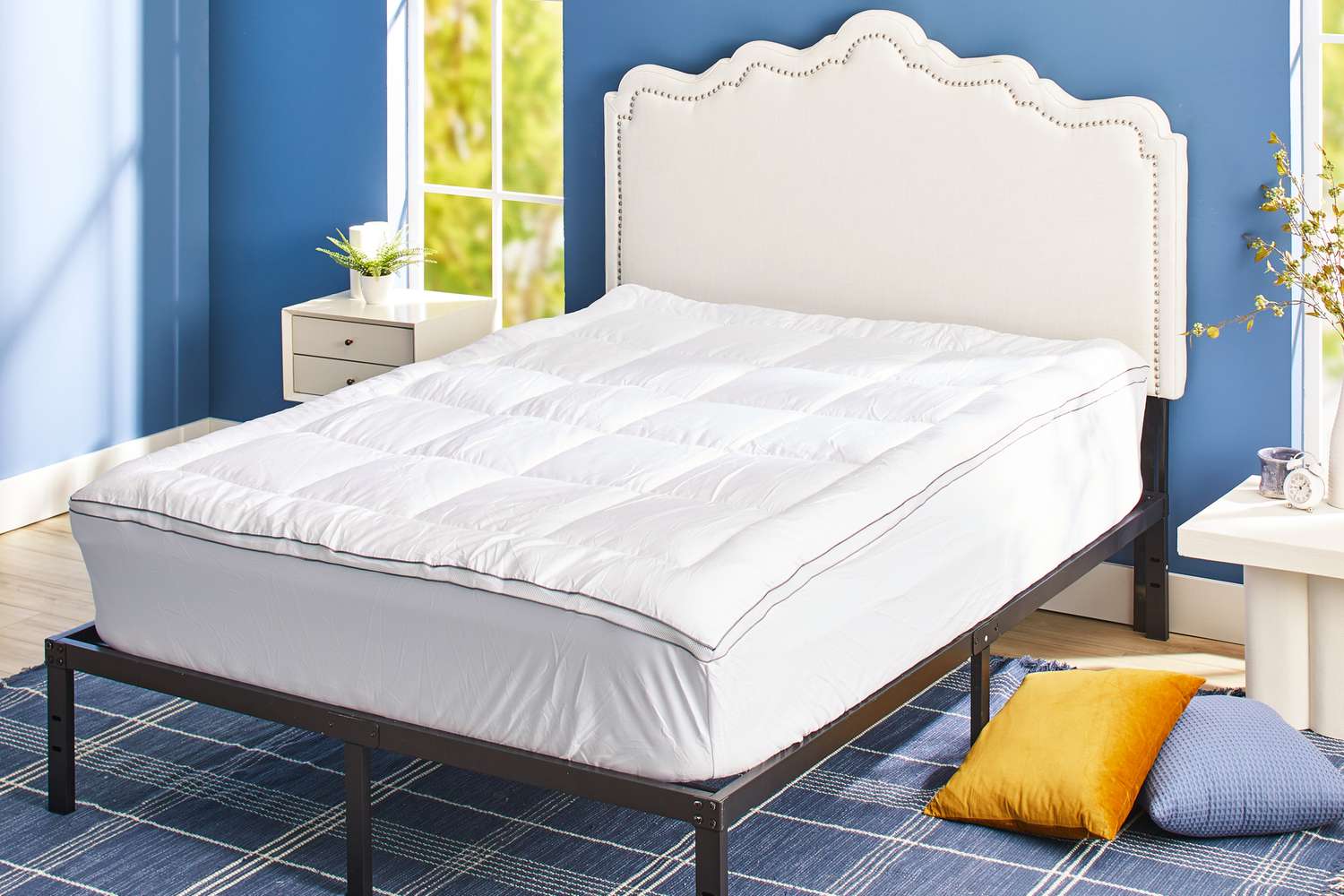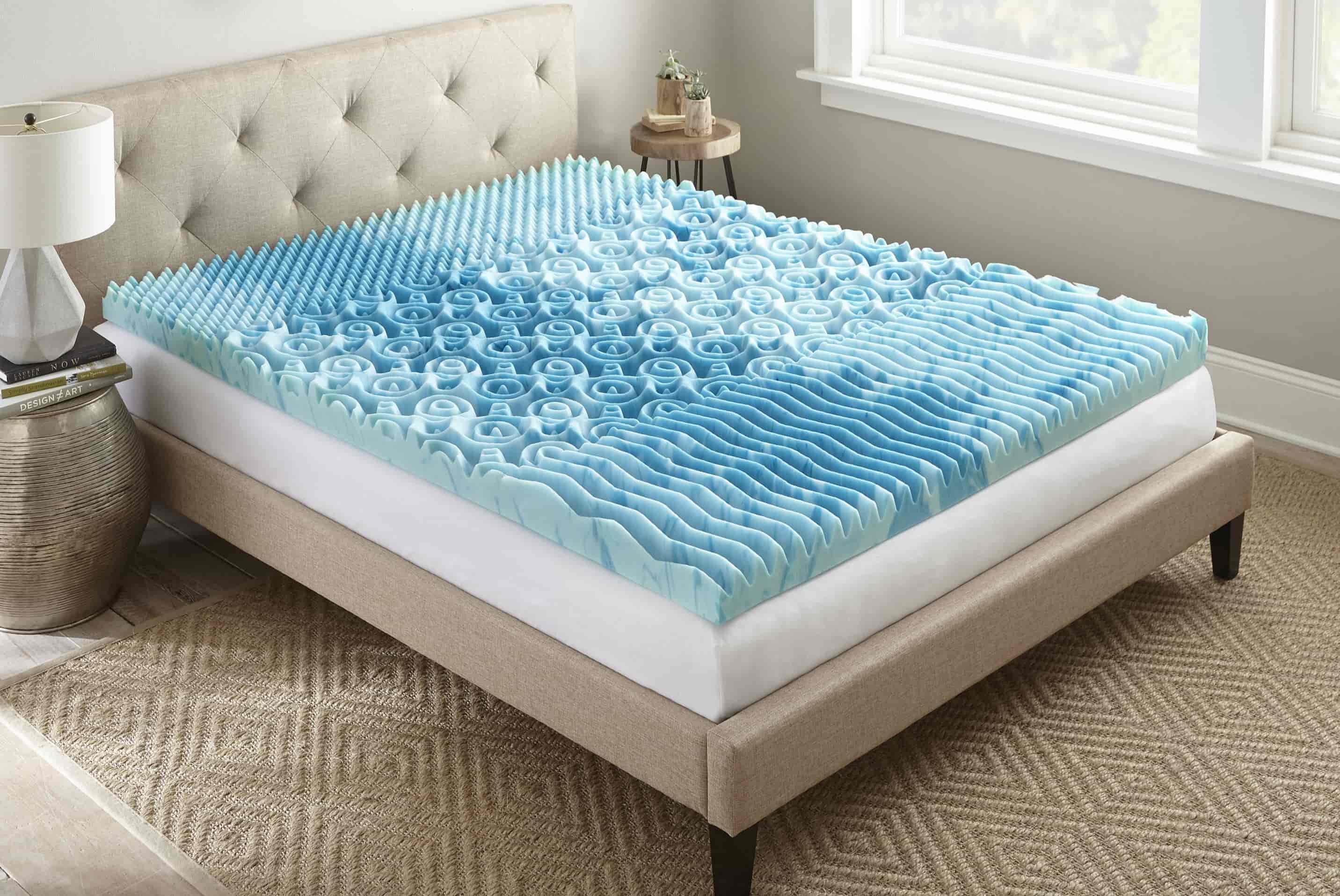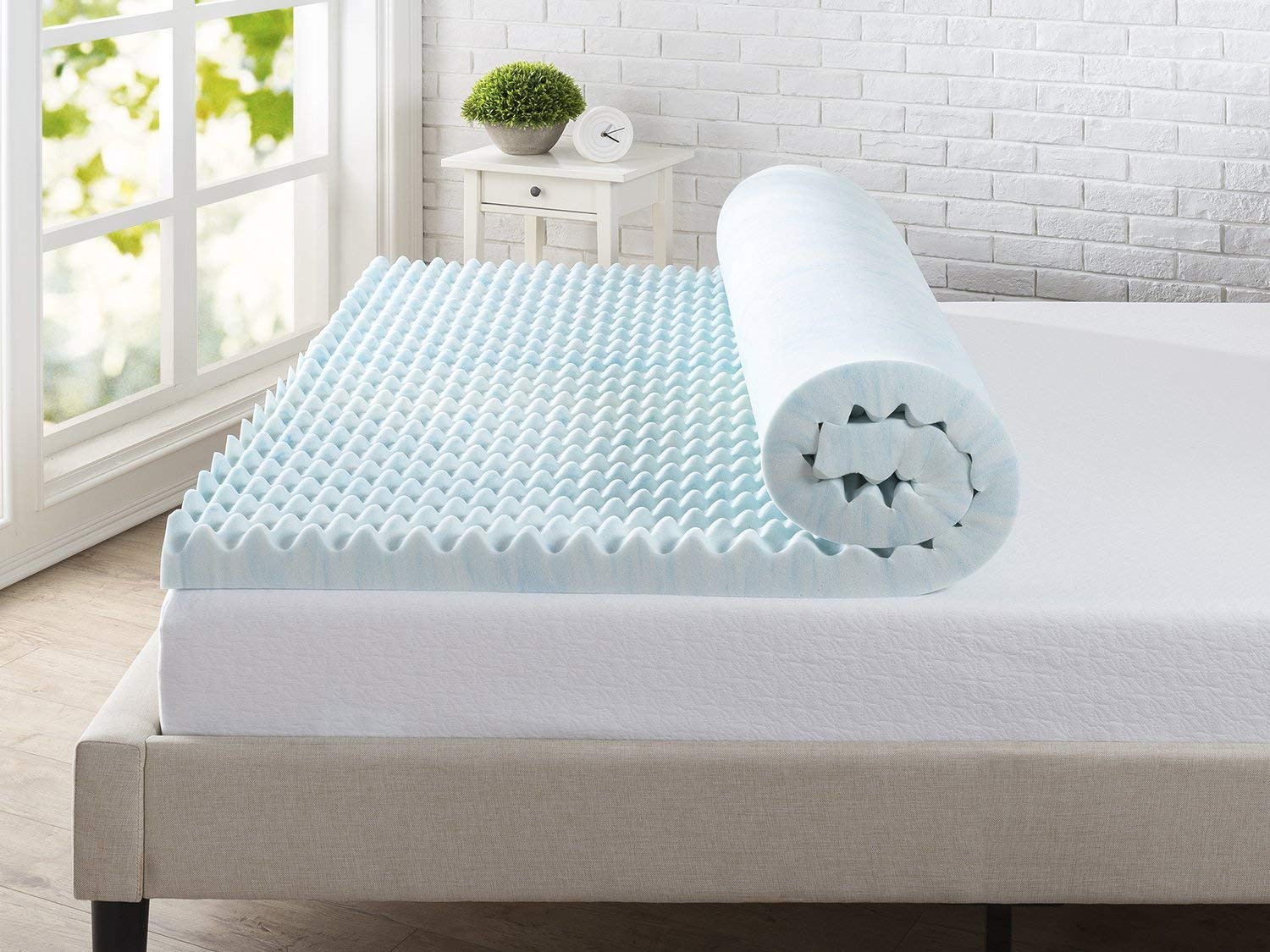Home>Furniture>Bedroom Furniture>What Does A Mattress Topper Do
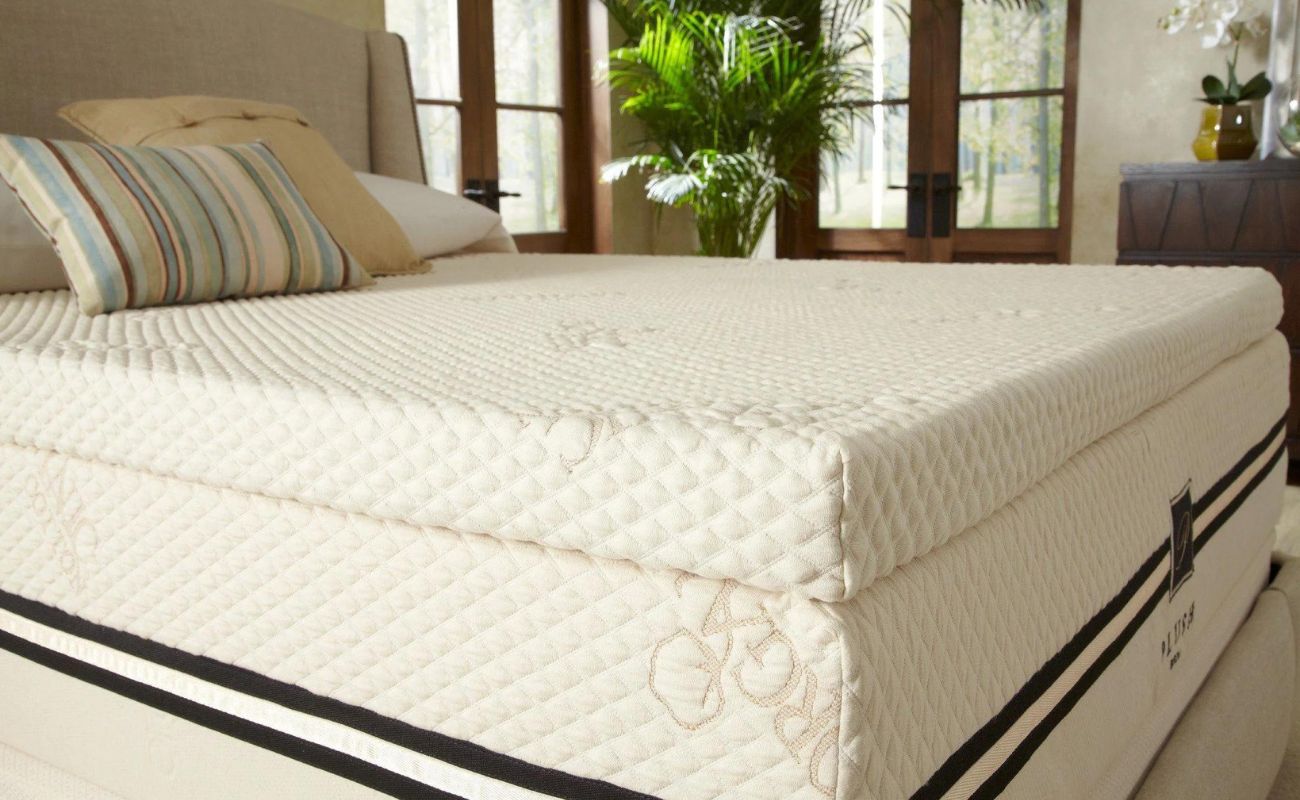

Bedroom Furniture
What Does A Mattress Topper Do
Modified: January 18, 2024
Discover the benefits of a mattress topper for your bedroom furniture. Enhance comfort and prolong the life of your mattress with this essential bedding accessory.
(Many of the links in this article redirect to a specific reviewed product. Your purchase of these products through affiliate links helps to generate commission for Storables.com, at no extra cost. Learn more)
Introduction
When it comes to creating the perfect sleep environment, a comfortable and supportive mattress is essential. However, sometimes even the most high-quality mattress may not provide the desired level of comfort. This is where a mattress topper can come to the rescue.
A mattress topper is an additional layer of padding that is placed on top of the mattress to enhance its comfort and support. It acts as a protective barrier and can be easily removed and replaced, allowing you to customize your sleep experience without investing in a new mattress.
There are various types of mattress toppers available on the market, each offering unique benefits and features. From memory foam to latex, down-filled to wool, the options are endless. In this article, we will explore the different types of mattress toppers and delve into the many benefits they provide, helping you make an informed decision when choosing the perfect addition to your bedroom retreat.
So, whether you want to add an extra layer of softness, improve the support of your mattress, relieve pressure points, or regulate temperature, a mattress topper can be an excellent investment. Let’s discover why mattress toppers are gaining popularity and why you should consider adding one to your sleep setup.
Key Takeaways:
- Transform your sleep experience with a mattress topper, offering comfort, support, and temperature regulation. Choose from various materials to customize your ideal sleeping surface.
- Enhance your mattress with a topper to relieve pressure points, improve support, and extend its lifespan. Find the perfect balance of comfort and hygiene for a restful night’s sleep.
Types of Mattress Toppers
When it comes to choosing a mattress topper, there is a wide range of materials to consider. Each type of mattress topper offers unique characteristics and benefits, catering to different preferences and needs. Here are some of the most popular types of mattress toppers:
- Memory Foam: Memory foam mattress toppers are a popular choice due to their contouring and pressure-relieving properties. They conform to the shape of your body, reducing pressure points and promoting proper spinal alignment. Memory foam toppers come in a variety of thicknesses and densities to suit individual preferences.
- Latex: Latex mattress toppers are hypoallergenic and known for their resilience and durability. They provide excellent support and comfort by evenly distributing weight across the surface. Latex toppers have a natural bounce and offer good temperature regulation for a cool and comfortable sleep.
- Down-filled: Down-filled mattress toppers are soft and plush, providing a luxurious sleeping surface. The down feathers provide excellent insulation and breathability, keeping you warm in winter and cool in summer. However, down-filled toppers may require regular fluffing and air circulation to maintain their loft.
- Wool: Wool mattress toppers offer natural insulation, moisture-wicking properties, and temperature regulation. They are breathable and hypoallergenic, making them a great choice for individuals with allergies or sensitivities. Wool toppers provide a soft and comfortable sleep surface while allowing air to circulate, ensuring a fresh and dry sleeping environment.
- Featherbed: Featherbed toppers have a plush and cloud-like feel, thanks to the combination of down and feather fillings. They provide a soft and cozy sleeping surface while adding an extra layer of insulation. Featherbed toppers are known for their fluffiness and comfort, making you feel like you’re sleeping on a fluffy cloud.
- Gel-infused: Gel-infused mattress toppers are designed to regulate temperature and provide a cool sleep experience. The gel beads or swirls integrated into the foam help dissipate heat and prevent overheating during the night. Gel-infused toppers offer the benefits of memory foam with the added advantage of temperature control.
It’s important to consider your personal preferences and specific needs when choosing a mattress topper. Whether you prefer a plush, contouring feel or a cool and supportive surface, there is a mattress topper out there to cater to your sleep preferences. Next, let’s explore the benefits of using a mattress topper.
Benefits of Using a Mattress Topper
Adding a mattress topper to your bed can offer a range of benefits that contribute to a better sleep experience. Here are some of the advantages of using a mattress topper:
- Improves Comfort: One of the main reasons people choose to use a mattress topper is to enhance overall comfort. Whether your mattress is too firm or too soft for your liking, a mattress topper can add an extra layer of cushioning or support to create a more comfortable sleep surface.
- Enhances Mattress Support: If you find that your mattress lacks proper support, a mattress topper can provide an additional layer of supportiveness. This can be especially beneficial for individuals suffering from back or joint pain, as it helps align the spine and relieve pressure points.
- Provides Pressure Relief: Certain mattress toppers, such as memory foam and latex, are known for their ability to distribute weight evenly and reduce pressure points. By alleviating pressure on sensitive areas such as hips and shoulders, mattress toppers help promote better blood circulation and alleviate discomfort during sleep.
- Cooling Effect: Many mattress toppers are designed with cooling properties to regulate temperature and prevent overheating. Gel-infused toppers, for example, dissipate heat away from the body, keeping you cool and comfortable throughout the night.
- Hygiene and Allergy Control: Mattress toppers act as a barrier between you and your mattress, helping to protect against allergens, dust mites, and other potential irritants. Toppers made from hypoallergenic materials, such as latex or wool, can reduce the risk of allergic reactions and provide a cleaner sleep environment.
- Extends Mattress Lifespan: By adding a mattress topper, you can help prolong the lifespan of your mattress. The topper acts as a protective layer, preventing direct contact between your body and the mattress, which can help reduce wear and tear over time.
Considering these benefits, it’s clear that a mattress topper can be a valuable addition to your sleeping setup. However, it’s important to keep in mind that not all mattress toppers are created equal. In the next section, we will explore the factors you should consider when choosing a mattress topper to ensure you find the perfect fit for your needs.
Improves Comfort
One of the primary reasons people invest in a mattress topper is to improve overall comfort while sleeping. Whether you find your mattress too firm, too soft, or simply in need of an extra layer of cushioning, a mattress topper can provide the solution you’re looking for.
When adding a mattress topper to your bed, you have the flexibility to choose the level of comfort that suits your preferences. If you prefer a plush and sink-in feel, a soft and fluffy topper, such as a down-filled or featherbed topper, can provide a luxurious sleeping surface. On the other hand, if your mattress feels too soft and lacks support, a firmer topper, like a memory foam or latex topper, can add the needed stability and contouring support.
Additionally, a mattress topper can help eliminate the feeling of sagging or sinking that may occur over time with an older mattress. The added layer of padding can restore the mattress’s surface, giving it a more even and comfortable feel.
By improving the comfort level of your mattress, a mattress topper can contribute to a more restful and rejuvenating sleep experience. It helps ensure that you wake up feeling refreshed and ready to tackle the day.
Furthermore, investing in a mattress topper can be a cost-effective alternative to purchasing a new mattress. If your current mattress is still in good condition but lacks the desired comfort, a mattress topper can be an affordable solution to improve your sleep quality without breaking the bank.
Overall, a mattress topper provides the opportunity to customize your sleeping surface, allowing you to achieve the level of comfort that suits your unique needs and preferences. Whether you prefer a soft cloud-like feel or a supportive and contouring surface, a mattress topper can be the key to transforming your bed into a cozy and inviting retreat.
Enhances Mattress Support
If you find that your mattress lacks proper support, a mattress topper can be a game-changer. A topper acts as an additional layer of padding and support, providing extra firmness or cushioning to enhance the overall supportiveness of your mattress.
Having proper support while you sleep is crucial for maintaining a healthy spinal alignment and reducing the risk of developing back or joint pain. A mattress topper can help address common issues such as sagging or a lack of support in certain areas of the mattress.
For those who prefer a firmer sleeping surface, a memory foam topper can offer excellent support by contouring to the curves of your body and evenly distributing weight. This can help alleviate pressure points and promote proper spinal alignment, reducing strain on your back and joints.
On the other hand, if your mattress is too firm and you’re looking for a bit of plushness, a down-filled or wool topper can add a soft and cozy layer while still providing adequate support. These materials offer a combination of cushioning and bounce, ensuring your body is properly supported during sleep.
Latex toppers are highly regarded for their responsiveness and support. They offer a balanced level of firmness and contouring, providing optimal support to different sleep positions. Latex toppers are also known for their durability, so you can expect a long-lasting and supportive sleeping surface.
By enhancing the support of your mattress with a topper, you can experience improved posture, reduced pressure on your joints, and a more comfortable sleep experience overall. It’s important to choose a topper that complements the level of support you desire and aligns with your sleep preferences.
Adding a mattress topper is a cost-effective way to enhance the support of your mattress without having to invest in a new one. It can extend the life of your existing mattress while providing the desired level of support for a more restful sleep.
Overall, a mattress topper can significantly improve the support of your mattress, ensuring proper alignment of your spine and relieving pressure points. With enhanced support, you can wake up feeling refreshed and rejuvenated, ready to take on the day ahead.
Read more: What Mattress Toppers Are Best
Provides Pressure Relief
One of the key benefits of using a mattress topper is its ability to provide pressure relief. Sleeping on an unsupportive mattress can lead to the development of pressure points, which can cause discomfort and disrupt your sleep. A mattress topper can help alleviate these pressure points by distributing your body weight more evenly.
Memory foam mattress toppers are especially renowned for their pressure-relieving properties. They are designed to conform to the shape of your body, cradling it and reducing the pressure on sensitive areas such as the hips, shoulders, and joints. This can help alleviate pain, improve blood circulation, and promote a more comfortable and restful sleep.
Latex mattress toppers also offer excellent pressure relief, as they have a natural bounce and responsiveness. They adjust to your body shape, providing support and cushioning while minimizing pressure points. This makes them a favorable choice for users seeking a resilient and comfortable sleep surface.
The plushness of down-filled and featherbed toppers can also aid in pressure relief. These toppers provide a soft and cushiony layer that allows your body to sink in slightly, reducing pressure on specific areas. However, it’s worth noting that these toppers may not offer as much targeted pressure relief as memory foam or latex toppers.
By incorporating a mattress topper into your sleep setup, you can experience a reduction in aches, pains, and discomfort caused by pressure points. The topper helps distribute your body weight more evenly, minimizing the stress on any particular area and allowing you to wake up feeling refreshed and rejuvenated.
It’s important to consider your individual needs and preferences when selecting a mattress topper for pressure relief. The thickness and density of the topper, as well as its material and construction, can all affect its ability to alleviate pressure points effectively. Choose a topper that provides the right balance of cushioning and support for your body, ensuring optimal pressure relief throughout the night.
Overall, adding a mattress topper to your bed can be an effective solution for reducing pressure points and enhancing your sleep quality. With improved pressure relief, you can enjoy a more comfortable and soothing sleep experience, waking up feeling rested and revitalized.
Cooling Effect
Are you tired of waking up hot and sweaty in the middle of the night? If so, a mattress topper with cooling properties can be a game-changer. Many mattress toppers are specifically designed with materials and technologies that help regulate temperature and provide a cooler sleep environment.
Gel-infused memory foam toppers are a popular choice for individuals who struggle with overheating during sleep. The gel beads or swirls integrated into the foam help dissipate heat away from the body, offering a cooler and more comfortable sleep experience. The gel-infused topper can effectively absorb and redistribute body heat, preventing it from getting trapped and causing discomfort.
Bamboo-derived rayon and Tencel toppers are also known for their excellent moisture-wicking and breathability properties. These materials have natural cooling abilities, allowing air to circulate and dissipate heat, keeping you cool and dry throughout the night. Additionally, they are hypoallergenic and resistant to dust mites, making them a great choice for allergy sufferers.
Another cooling option is a latex mattress topper. Latex is highly breathable and has natural temperature-regulating properties. It allows for better airflow, keeping you cool in hot weather and preventing heat buildup. Latex toppers can provide a refreshing and comfortable sleep experience year-round.
It’s important to note that not all mattress toppers with cooling properties will have the same level of effectiveness. The cooling capabilities can vary depending on the materials used, construction, and personal preferences. If you tend to sleep hot, it’s worthwhile to invest in a high-quality cooling mattress topper that suits your needs.
By incorporating a cooling mattress topper into your sleep setup, you can say goodbye to uncomfortable nights of tossing and turning due to excessive heat. The topper will help regulate your body temperature and provide a cooler sleep surface, allowing you to enjoy a more restful and refreshing night’s sleep.
When choosing a cooling mattress topper, consider factors such as its breathability, moisture-wicking properties, and heat dissipation capabilities. It’s also important to ensure that the topper is compatible with your existing mattress and does not compromise on the comfort and support you need.
With a cooling mattress topper, you can finally experience a more comfortable and temperature-controlled sleep environment, enabling you to wake up feeling revitalized and ready to take on the day.
Hygiene and Allergy Control
Creating a clean and allergen-free sleep environment is essential for a healthy and restful night’s sleep. A mattress topper can play a significant role in maintaining hygiene and controlling allergies, providing you with a healthier and more comfortable sleeping surface.
One of the main advantages of using a mattress topper is that it acts as a protective barrier between you and your mattress. It helps prevent direct contact between your body and the mattress, reducing the risk of sweat, dead skin cells, and other bodily fluids from seeping into the mattress. This makes it easier to keep your sleep surface clean and hygienic.
Additionally, mattress toppers made from hypoallergenic materials can help minimize the presence of allergens like dust mites, pet dander, and pollen in your sleep environment. Materials such as latex and wool naturally resist allergens and inhibit their growth, creating a more allergy-friendly sleeping surface.
Wool mattress toppers, in particular, have antimicrobial properties that help prevent the accumulation of bacteria and dust mites. Wool is also naturally resistant to mold and mildew, making it an excellent choice for individuals with allergies or sensitivities.
Furthermore, some mattress toppers are specifically designed with hypoallergenic materials, such as hypoallergenic down or synthetic fibers. These toppers are resistant to allergens and provide a cleaner sleep environment, reducing the risk of exacerbating allergy symptoms and asthma.
To maintain the hygiene of your mattress topper, it’s important to follow the manufacturer’s cleaning instructions. Most mattress toppers can be spot cleaned or machine washed, while others may require professional cleaning. Regularly cleaning and airing out your topper helps eliminate any accumulated allergens and ensures a fresher and more hygienic sleeping surface.
When selecting a mattress topper for hygiene and allergy control, consider factors such as the materials used, their hypoallergenic properties, and resistance to allergens. Look for certifications such as CertiPUR-US® or OEKO-TEX® Standard 100, which ensure that the materials used are free from harmful substances.
By using a mattress topper that promotes hygiene and controls allergies, you can enjoy a cleaner sleep environment, free from allergens and irritants. This can lead to less congestion, fewer allergy symptoms, and a more relaxing and rejuvenating sleep experience.
Extends Mattress Lifespan
Investing in a high-quality mattress is a significant financial decision, and you want to ensure that it lasts for as long as possible. A mattress topper can help extend the lifespan of your mattress by providing an additional layer of protection and minimizing wear and tear.
By placing a mattress topper on top of your mattress, you create a barrier that helps shield it from stains, spills, and contaminants. The topper acts as a protective layer, absorbing any accidental spills or bodily fluids, preventing them from seeping into the mattress. This can be particularly beneficial if you have children or pets who may be prone to accidents.
In addition to protecting against stains, a mattress topper can also help reduce the accumulation of dust, allergens, and debris on the surface of your mattress. This can contribute to a cleaner sleep environment and minimize the chance of irritants affecting your sleep quality.
Mattress toppers also help distribute the weight and pressure applied to the mattress, reducing the strain on individual areas and preventing uneven wear. This can help extend the lifespan of your mattress by preserving its structural integrity over time. It’s like adding an extra layer of cushioning that absorbs some of the impact, ensuring that your mattress remains in good shape for a longer period.
Furthermore, if you have a mattress with a non-removable cover or that cannot be easily cleaned, a mattress topper can provide an alternative solution for maintaining cleanliness. Toppers are generally easier to clean or replace, allowing you to keep your sleep surface fresh and hygienic without requiring extensive maintenance.
While a mattress topper can help prolong the lifespan of your mattress, it’s important to note that it cannot fix an already worn-out or sagging mattress. If your mattress has reached the end of its lifespan or is causing discomfort, it may be time to consider replacing it.
When selecting a mattress topper to extend the lifespan of your mattress, consider factors such as the quality of the materials, thickness, and density. It’s also important to choose a topper that is compatible with your existing mattress and provides the desired level of comfort and support.
By adding a mattress topper, you can protect your investment and enjoy a longer-lasting and more comfortable sleep surface. It’s a cost-effective way to extend the lifespan of your mattress and ensure many more nights of restful sleep.
A mattress topper can provide extra comfort and support to your mattress. It can also help to extend the life of your mattress by providing an additional layer of protection.
Read more: What Are The Best Mattress Toppers
Factors to Consider When Choosing a Mattress Topper
When it comes to selecting the perfect mattress topper, there are several important factors to consider. By keeping these factors in mind, you can ensure that you choose a topper that meets your specific needs and preferences. Here are some key factors to consider:
- Material and Construction: The material and construction of the topper can significantly impact its comfort, support, and durability. Consider options such as memory foam, latex, down-filled, wool, or gel-infused foam. Each material offers unique characteristics, so choose one that aligns with your preferences and requirements.
- Thickness and Density: The thickness and density of the topper will determine its level of cushioning and support. Thicker toppers often provide more plushness, while denser toppers offer greater support. Keep in mind that thicker toppers may alter the feel of your mattress more noticeably than thinner ones.
- Firmness Level: The firmness of the topper should complement your preferred level of comfort. Consider whether you prefer a soft, medium, or firm topper. Keep in mind that the firmness of the topper will interact with the existing firmness of your mattress, so aim for a harmonious balance.
- Temperature Regulation: If you tend to sleep hot, consider a mattress topper with cooling properties, such as gel-infused foam or materials with natural breathability. These options can help regulate temperature and prevent overheating, promoting a more comfortable sleep environment.
- Allergen Resistance: If you have allergies or sensitivities, consider hypoallergenic mattress toppers made from materials like latex or wool. These materials naturally resist allergens, dust mites, and mold, providing a cleaner and healthier sleep surface.
- Price Range: Set a budget for your mattress topper and consider options within that range. Prices can vary depending on the quality, material, and features of the topper. Remember that a higher price doesn’t always guarantee better quality, so balance your budget with your desired features.
Additionally, consider factors such as the topper’s maintenance requirements, its compatibility with your mattress (size and thickness), and any warranties or return policies offered by the manufacturer.
Ultimately, the best mattress topper for you will depend on your personal preferences, sleeping position, and specific needs. It’s important to choose a topper that provides the right balance of comfort, support, and other desired features to enhance your sleep experience.
By carefully considering these factors and conducting thorough research, you can make an informed decision and select a mattress topper that will transform your bed into a comfortable and supportive haven.
Material and Construction
The material and construction of a mattress topper play a crucial role in determining its comfort, support, durability, and other important aspects of its performance. Understanding the different materials and construction options available can help you choose a topper that meets your specific needs and preferences. Here are some common materials and constructions used in mattress toppers:
- Memory Foam: Memory foam toppers are known for their excellent contouring and pressure-relieving properties. They are constructed using viscoelastic foam that responds to heat and pressure, conforming to the shape of your body. Memory foam toppers provide a plush and supportive sleep surface, reducing pressure points and promoting proper spinal alignment.
- Latex: Latex toppers are made from natural or synthetic latex materials. Natural latex is sourced from rubber trees and provides a resilient and breathable sleep surface. Latex toppers offer excellent support, responsiveness, and durability. They are hypoallergenic, resistant to dust mites and mold, and provide a cooler sleep experience compared to memory foam.
- Down-filled: Down-filled toppers are plush and luxurious, offering a soft and fluffy sleep surface. These toppers are filled with the fine feathers found under the exterior feathers of geese or ducks. They provide excellent insulation and breathability, keeping you warm in winter and cool in summer. Down-filled toppers require regular fluffing and maintenance to maintain their loft.
- Wool: Wool toppers are made from natural wool fibers that offer exceptional temperature regulation and moisture-wicking properties. Wool provides a soft and plush sleep surface while allowing air circulation to prevent overheating. Wool is naturally hypoallergenic, resistant to dust mites and mold, and has antimicrobial properties that contribute to a clean and hygienic sleep environment.
- Featherbed: Featherbed toppers are filled with a combination of down and feathers, providing a plush and cloud-like feel. These toppers offer a luxurious sleep experience and excellent insulation. Featherbed toppers require regular fluffing and maintenance to maintain their loft and ensure even distribution of filling material.
- Gel-infused Foam: Gel-infused foam toppers are constructed using memory foam infused with gel particles or beads. The gel helps dissipate heat and regulate temperature, preventing overheating during sleep. Gel-infused toppers offer the benefits of memory foam, such as contouring and pressure relief, with the added advantage of temperature control.
The choice of material and construction depends on your preferences, sleeping position, and specific needs. Consider factors such as the level of support, cushioning, breathability, responsiveness, and temperature regulation when selecting a mattress topper. Additionally, take into account any personal allergies or sensitivities to ensure that the chosen material is hypoallergenic and resistant to allergens.
It’s important to note that each material and construction has its own characteristics and benefits. Therefore, it’s essential to take the time to research and test different options to determine which one suits your preferences and provides the desired level of comfort and support.
By understanding the material and construction of mattress toppers, you can make a well-informed decision and choose a topper that enhances your sleep quality and transforms your bed into a cozy and inviting sanctuary.
Thickness and Density
The thickness and density of a mattress topper are important factors to consider when choosing the right one for your needs. These aspects can significantly impact the level of comfort, support, and overall performance of the topper. Let’s take a closer look at how thickness and density play a role in mattress toppers:
Thickness: The thickness of a mattress topper refers to the height or depth of the topper. Toppers can range in thickness from 1 to 4 inches or more. A thicker topper generally provides more cushioning and can alter the feel of your mattress more noticeably. If you prefer a softer and more plush sleeping surface, a thicker topper may be a suitable choice. On the other hand, if you prefer a minimal change in the feel of your mattress, a thinner topper may be a better option.
When considering the thickness of a topper, it’s important to also consider the height of your mattress and any fitted sheets you use. If the topper adds significant height, it may affect the overall fit and appearance of your bedding. Make sure to measure the combined height of your mattress and topper to ensure compatibility with your sheets and mattress protectors.
Density: The density of a mattress topper refers to the weight and compactness of the material used in its construction. It is typically measured in pounds per cubic foot (lbs/ft³) for foam-based toppers. Higher density toppers are more durable, supportive, and better at distributing weight. They tend to have a firmer feel and provide more overall support. Lower density toppers, on the other hand, are softer and provide a plusher feel.
When selecting a density level, consider your body weight and personal preferences. Heavier individuals typically benefit from higher density toppers to ensure proper support and prevent excessive sinking. Lighter individuals may find lower density toppers more comfortable and responsive. It’s worth noting that density can affect the overall life expectancy and durability of the topper. Higher density toppers generally have a longer lifespan compared to lower density options.
It’s important to keep in mind that both thickness and density interact with the existing characteristics of your mattress. If you have a firm mattress and desire more cushioning, a thicker and lower density topper may be suitable. If your mattress is already quite soft, a thinner and higher density topper can provide additional support without excessively softening the surface.
Ultimately, the ideal thickness and density of a mattress topper depend on your individual preferences, desired level of comfort and support, and the characteristics of your existing mattress. Take the time to consider these factors and choose a topper that complements and enhances your sleep experience.
Firmness Level
The firmness level of a mattress topper plays a crucial role in determining how well it aligns with your ideal comfort and support needs. Different individuals have varying preferences when it comes to mattress firmness, so it’s important to choose a topper that suits your sleeping style and desired level of firmness. Here’s a closer look at the factors to consider when determining the firmness level of a mattress topper:
Sleeping Position: Your sleeping position can influence the ideal firmness level for your mattress topper. Here are some general guidelines:
- Side Sleepers: Side sleepers generally benefit from a slightly softer topper that allows their shoulders and hips to sink in slightly, promoting proper spinal alignment and relieving pressure points.
- Back Sleepers: Back sleepers typically require a topper that offers a balance of softness and support. It should contour to the natural curves of the body while maintaining proper spinal alignment.
- Stomach Sleepers: Stomach sleepers may prefer a firmer topper that helps keep their spine aligned and prevents any sinking of the torso, which can lead to lower back discomfort.
Personal Preference: Your personal preference for mattress firmness is important to consider. Some individuals prefer the plush feel of a softer topper, while others enjoy the support and stability of a firmer surface. It’s essential to choose a firmness level that aligns with your preferences and helps you achieve a restful night’s sleep.
Mattress Compatibility: When selecting a topper, keep in mind the existing firmness level of your mattress. The topper should harmonize with your mattress, providing the desired level of comfort and support without drastically altering the overall feel. For instance, if your mattress is already quite firm, a softer topper can help add a layer of plushness. Conversely, if your mattress is on the softer side and lacks adequate support, a firmer topper can improve the overall feel and prevent excessive sinking.
When determining the firmness level of a mattress topper, consider options that clearly indicate their firmness, such as soft, medium, or firm. Some toppers may have a universal firmness level, while others may provide a range of options to cater to different preferences. Customer reviews and experiences can also provide insights into the firmness of a topper.
Keep in mind that personal preference plays a significant role in determining the ideal firmness level. What feels comfortable to one person may not be the same for another. Take the time to test different options or choose a topper that offers a generous return policy, allowing you to adjust to its feel and determine if it meets your desired level of firmness.
By selecting a mattress topper with the right firmness level, you can optimize your sleep and wake up feeling rested and refreshed.
Read more: What To Look For In A Mattress Topper
Temperature Regulation
Achieving a comfortable sleep temperature is crucial for a restful night’s sleep. If you find yourself feeling too hot or too cold during the night, choosing a mattress topper that helps regulate temperature can make a significant difference. Here are some key factors to consider for temperature regulation when selecting a mattress topper:
Material: The material used in the construction of the topper plays a significant role in temperature regulation. Some materials, such as memory foam, have a tendency to retain body heat, potentially causing discomfort for individuals who sleep hot. On the other hand, materials like latex, wool, or gel-infused foam have better temperature-neutral properties, allowing for better airflow and heat dissipation.
Breathability: The breathability of a topper determines how well it allows air to flow through it, helping to dissipate heat and maintain a cool sleep surface. Materials like latex and wool naturally have breathable properties, allowing air to circulate more freely. Additionally, toppers with open-cell or ventilated designs enhance breathability and temperature regulation.
Gel-infused or Cooling Technology: Some mattress toppers are specifically designed to have cooling features, such as gel-infused memory foam. The gel particles or beads integrated into the foam help dissipate heat and regulate temperature throughout the night. Other cooling technologies, like phase-change materials (PCM), can absorb and release heat to provide temperature control.
Moisture-Wicking: Materials with moisture-wicking properties, such as bamboo-derived rayon or Tencel, can help manage sweat and moisture buildup, contributing to a cooler and drier sleep surface. These materials absorb and wick away perspiration, preventing it from clinging to your body and leading to discomfort.
Personal Preferences and Environment: Consider your personal preferences and the climate in which you live. If you naturally tend to sleep hot, opt for a topper that prioritizes breathability and cooling properties. Similarly, individuals living in warmer climates may prefer toppers with better heat regulation. On the other hand, those who tend to feel cold may benefit from a topper that provides a bit of insulation and warmth, like down or wool.
It’s important to note that temperature regulation can vary from person to person, as everyone has individual sleep preferences and body heat levels. However, by selecting a mattress topper that addresses temperature concerns and offers features like breathability or cooling technology, you can create a more optimal sleep environment for a comfortable and undisturbed night’s rest.
Allergen Resistance
Creating a sleep environment that promotes clean and healthy air is vital, especially for those who suffer from allergies or sensitivities. A mattress topper with allergen-resistant properties can play a crucial role in creating a more allergy-friendly sleep surface. Here are some important factors to consider for allergen resistance when selecting a mattress topper:
Material Selection: The material used in the construction of the topper determines its ability to resist allergens. Some materials naturally repel common allergens, such as dust mites, mold, and pet dander. Opt for toppers made from hypoallergenic materials like latex or wool, as they are inherently resistant to these allergens.
Hypoallergenic Properties: Look for mattress toppers that advertise hypoallergenic properties. Toppers with this designation have been specifically tested and certified to be free from common allergens and irritants. Certifications like CertiPUR-US® or OEKO-TEX® Standard 100 ensure that the topper meets stringent criteria regarding harmful substances.
Dust Mite Resistance: Dust mites are a common allergen found in many households. Look for toppers that are specifically designed to repel dust mites. Toppers made from materials like latex or those with tightly woven fabric covers are less likely to harbor dust mites, ensuring a cleaner and healthier sleep environment.
Mold and Mildew Resistance: Toppers made from materials with natural antimicrobial properties, such as wool, naturally resist the growth of mold and mildew. These materials inhibit the growth of these allergens, reducing the risk of respiratory irritations and allergies.
Regular Cleaning and Maintenance: Regular cleaning and maintenance of your mattress topper are essential to keep allergens at bay. Check the manufacturer’s guidelines for cleaning instructions. Some toppers may be machine washable, while others may require spot cleaning or professional cleaning.
Encasement Options: Using an allergen-proof encasement or cover for your mattress topper can provide an additional barrier against allergens. Look for covers that are specifically designed to be hypoallergenic and dust mite-resistant.
By choosing a mattress topper with allergen-resistant properties, you can create a sleep surface that is less likely to harbor common allergens, providing relief for allergy sufferers. These toppers create a protective barrier between you and potential irritants, promoting cleaner air and a healthier sleep environment.
It’s important to remember that while an allergen-resistant mattress topper can help reduce allergen exposure, it may not eliminate all allergens in your bedroom. Regular cleaning, maintaining low humidity levels, and using hypoallergenic bedding can all contribute to a cleaner sleep space for those with allergies or sensitivities.
By selecting a mattress topper that promotes allergen resistance, you can enjoy a more comfortable and healthier sleep, free from common allergens and irritants.
Price Range
When considering a mattress topper, understanding the price range is important to ensure that you stay within your budget while still finding a topper that meets your needs. The price of a mattress topper can vary depending on several factors including the material used, size, thickness, and brand reputation. Here’s a breakdown of different price ranges to consider:
Budget-Friendly: If you are looking for an affordable option, there are budget-friendly mattress toppers available. These toppers are usually made with less expensive materials and may have a simpler construction. While they might not have the same durability or luxury features as higher-end options, they can still provide added comfort and support to your mattress within a more limited budget.
Mid-Range: Mid-range mattress toppers offer a good balance between quality and cost. They are typically made with higher-quality materials and may offer additional features such as improved airflow or cooling properties. Mid-range options can be a good choice for those seeking a higher level of comfort and durability without breaking the bank.
Premium: Premium mattress toppers are often made with top-tier materials and advanced construction techniques. They offer superior comfort, support, and longevity. Premium toppers may include features like temperature regulation, hypoallergenic properties, or special certifications. While they come with a higher price tag, they can provide a luxurious sleep experience and are often worth the investment for those who prioritize quality and longevity.
When considering the price range, it’s important to keep in mind that the cost may also be influenced by the size of the topper. Larger-sized toppers, such as those for California King or Queen-sized beds, may have higher price points compared to smaller-sized toppers for Twin or Full beds.
It’s recommended to set a budget based on your preferences and needs. Consider factors such as the expected lifespan of the topper, the reputation of the brand, and customer reviews to help make an informed decision. Remember that a higher price does not always guarantee better quality, so it’s essential to balance your budget with the features and benefits that matter most to you.
Additionally, keep an eye out for sales, promotions, or discounts offered by manufacturers or retailers. These can be a great way to score a higher-end topper at a more affordable price.
By considering your budget and exploring different price ranges, you can find a mattress topper that fits your financial parameters while still providing the desired comfort and support for a better night’s sleep.
Conclusion
A mattress topper can be a valuable addition to your sleep setup, offering a range of benefits that contribute to a comfortable and restful night’s sleep. Whether you want to enhance the comfort of your mattress, improve support, relieve pressure points, regulate temperature, or promote a cleaner sleep environment, there is a mattress topper available to meet your needs.
By understanding the different types of mattress toppers, such as memory foam, latex, down-filled, wool, or gel-infused, you can choose the one that aligns with your preferences and requirements. Consider factors like material, thickness, density, firmness level, and temperature regulation to ensure that you find the perfect topper for your needs.
Mattress toppers not only enhance the comfort of your sleep surface, but they also provide extra support, alleviate pressure points, regulate temperature, control allergens, and extend the lifespan of your mattress. They offer a cost-effective solution to improve your sleep experience without the expense of purchasing a new mattress.
Remember, personal preference plays a significant role in determining the ideal mattress topper for you. What works for one person may not work for another, so take the time to research, read customer reviews, and consider your own sleeping habits and needs.
Ultimately, investing in a high-quality mattress topper that suits your preferences and requirements can transform your bed into a cozy sanctuary, providing you with the comfort and support needed for a deep and rejuvenating sleep.
So, whether you’re looking to add a touch of plushness, improve support, regulate temperature, or create a cleaner sleep environment, a mattress topper is a worthwhile investment that can enhance your sleep quality and make a significant difference in your overall well-being.
Frequently Asked Questions about What Does A Mattress Topper Do
Was this page helpful?
At Storables.com, we guarantee accurate and reliable information. Our content, validated by Expert Board Contributors, is crafted following stringent Editorial Policies. We're committed to providing you with well-researched, expert-backed insights for all your informational needs.
